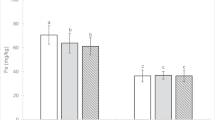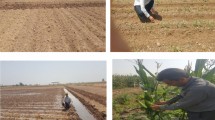Abstract
The underlying aim of biomass crops is to combine high yields and low nutrient contents. Delayed harvests of perennial grasses can reduce nutrient concentrations, while higher levels are generally observed at early harvests. However, depending on the supply chain and the conversion technology, harvesting before senescence could be viable, leading to multiple harvesting, improved feedstock digestibility, and wet biomass storage. In this study, the influence of harvest time and frequency of giant reed (Arundo donax L.) was assessed on aboveground nitrogen, phosphorus, and potassium concentrations, removal, and nutrient use efficiency. In order to evaluate the effects of different cutting regimes, three single harvest (SH) and six double harvest systems (DH) were compared. Nutrient concentrations declined over the season from 10.3 to 2.5 gN kg−1, from 1.8 to 0.8 gP kg−1, and from 30.0 to 8.2 gK kg−1. Overall, DH led to higher nutrient concentrations than SH. Biomass at second cut tended to be richer in nutrients when harvested in autumn compared with winter, and when first cuts were delayed. Nutrient removal was markedly higher in DH for all the elements considered (on average, 196 kgN, 43 kgP, 530 kgK ha−1 in DH, 111 kgN, 29 kgP, 297 kg Kha−1 in SH). In DH systems, nitrogen and potassium use efficiencies were nearly halved compared with single late cuts, while phosphorus use efficiency decreased by about 30 %. The high nutrient removal rates of double-cut management suggest that it may be not sustainable, unless nutrient cycles are closed and nitrogen losses are evaluated.
Similar content being viewed by others
References
Lewandowski I, Scurlock JM, Lindvall E, Christou M (2003) The development and current status of perennial rhizomatous grasses as energy crops in the US and Europe. Biomass Bioenergy 25(4):335–361
Zegada-Lizarazu W, Elbersen HW, Cosentino SL, Zatta A, Alexopoulou E, Monti A (2010) Agronomic aspects of future energy crops in Europe. Biofuels Bioprod Bioref 4:674–691
Karp A, Richter GM (2011) Meeting the challenge of food and energy security. J Exp Bot 62(10):3263–3271
Beale CV, Long SP (1997) Seasonal dynamics of nutrient accumulation and partitioning in the perennial C4-grasses Miscanthus × giganteus and Spartina cynosuroides. Biomass Bioenergy 12(6):419–428
Cadoux S, Riche AB, Yates NE, Machet JM (2012) Nutrient requirements of Miscanthus x giganteus: conclusions from a review of published studies. Biomass Bioenergy 38:14–22
Dohleman FG, Heaton EA, Arundale RA, Long SP (2012) Seasonal dynamics of above- and below-ground biomass and nitrogen partitioning in Miscanthus × giganteus and Panicum virgatum across three growing seasons. GCB Bioenergy 4(5):534–544
Strullu L, Cadoux S, Beaudoin N, Jeuffroy MH (2013) Influence of belowground nitrogen stocks on light interception and conversion of Miscanthus × giganteus. Eur J Agron 47:1–10
Nassi o Di Nasso NN, Roncucci N, Bonari E (2013) Seasonal dynamics of aboveground and belowground biomass and nutrient accumulation and remobilization in giant reed (Arundo donax L.): a three-year study on marginal land. Bioenergy Res 6(2):725–736
Angelini LG, Ceccarini L, Bonari E (2005) Biomass yield and energy balance of giant reed (Arundo donax L.) cropped in central Italy as related to different management practices. Eur J Agron 22(4):375–389
Monti A, Fazio S, Venturi G (2009) Cradle-to-farm gate life cycle assessment in perennial energy crops. Eur J Agron 31:77–84
Nackley LL, Kim SH (2014) A salt on the bioenergy and biological invasions debate: salinity tolerance of the invasive biomass feedstock Arundo donax. GCB Bioenergy. doi:10.1111/gcbb.12184
Scordia D, Cosentino SL, Jeffries TW (2013) Enzymatic hydrolysis, simultaneous saccharification and ethanol fermentation of oxalic acid pretreated giant reed (Arundo donax L.). Ind Crop Prod 49:392–399
Lemons e Silva CF, Artigas Schirmer M, Nobuyuki Maeda R, Araújo Barcelos C, Pereira N Jr (2014) Potential of giant reed (Arundo donax L.) for second generation ethanol production. Electron J Biotechnol 18(1):10–15
Barbanti L, Di Girolamo G, Grigatti M, Bertin L, Ciavatta C (2014) Anaerobic digestion of annual and multi-annual biomass crops. Ind Crop Prod 56:137–144
Ragaglini G, Dragoni F, Simone M, Bonari E (2014) Suitability of giant reed (Arundo donax L.) for anaerobic digestion: effect of harvest time and frequency on the biomethane yield potential. Bioresour Technol 152:107–115
Nassi o Di Nasso N, Angelini LG, Bonari E (2010) Influence of fertilisation and harvest time on fuel quality of giant reed (Arundo donax L.) in central Italy. Eur J Agron 32(3):219–227
Saikia R, Chutia RS, Kataki R, Pant KK (2015) Perennial grass (Arundo donax L.) as a feedstock for thermo-chemical conversion to energy and materials. Bioresour Technol 188:265–272
Angelini LG, Ceccarini L, Nassiodinasso N, Bonari E (2009) Comparison of Arundo donax L. and Miscanthus x giganteus in a long-term field experiment in central Italy: analysis of productive characteristics and energy balance. Biomass Bioenergy 33:635–643
Mantineo M, D’Agosta GM, Copani V, Patanè C, Cosentino SL (2009) Biomass yield and energy balance of three perennial crops for energy use in the semi-arid Mediterranean environment. Field Crop Res 114:204–213
Barney JN (2014) Bioenergy and invasive plants: quantifying and mitigating future risks. Invasive Plant Sci Manag 7(2):199–209
Boland JM (2006) The importance of layering in the rapid spread of Arundo donax (giant reed). Madrono 53(4):303–312
Smith R, Slater FM (2011) Mobilization of minerals and moisture loss during senescence of the energy crops Miscanthus x giganteus, Arundo donax and Phalaris arundinacea in Wales, UK. Global Change Biol Bioenergy 3(2011):148–157
Jørgensen U (1997) Genotypic variation in dry matter accumulation and content of N, K and Cl in Miscanthus in Denmark. Biomass Bioenergy 12(3):155–169
Obernberger I, Brunner T, Bärnthaler G (2006) Chemical properties of solid biofuels—significance and impact. Biomass Bioenergy 30(11):973–982
Monti A, Di Virgilio N, Venturi G (2008) Mineral composition and ash content of six major energy crops. Biomass Bioenergy 32(3):216–223
Dragoni F, Ragaglini G, Nassi o Di Nasso N, Tozzini C, Bonari E (2015) Aboveground yield and biomass quality of giant reed (Arundo donax L.) as affected by harvest time and frequency. Bioenergy Res 8(3):1321–1331
Triolo JM, Sommer SG, Moller HB, Weisbjerg MR, Jiang XY (2011) A new algorithm to characterize biodegradability of biomass during anaerobic digestion: influence of lignin concentration on methane production potential. Bioresour Technol 102:9395–9402
Kandel TP, Sutaryo S, Møller HB, Jørgensen U, Lærke PE (2013) Chemical composition and methane yield of reed canary grass as influenced by harvesting time and harvest frequency. Bioresour Technol 130:659–666
Digman MF, Shinners KJ, Casler MD, Dien BS, Hatfield RD, Jung HJG … Weimer PJ (2010) Optimizing on-farm pretreatment of perennial grasses for fuel ethanol production. Bioresour Technol 101(14):5305–5314
Greenhalf CE, Nowakowski DJ, Yates N, Shield I, Bridgwater AV (2013) The influence of harvest and storage on the properties of and fast pyrolysis products from Miscanthus x giganteus. Biomass Bioenergy 56:247–259
Heaton EA, Dohleman FG, Long SP (2009) Seasonal nitrogen dynamics of Miscanthus × giganteus and Panicum virgatum. GCB Bioenergy 1(4):297–307
Guretzky JA, Biermacher JT, Cook BJ, Kering MK, Mosali J (2011) Switchgrass for forage and bioenergy: harvest and nitrogen rate effects on biomass yields and nutrient composition. Plant Soil 339(1–2):69–81
Tahir MHN, Casler MD, Moore KJ, Brummer EC (2011) Biomass yield and quality of reed canarygrass under five harvest management systems for bioenergy production. Bioenergy Res 4:111–119
Kering MK, Butler TJ, Biermacher JT, Guretzky JA (2012) Biomass yield and nutrient removal rates of perennial grasses under nitrogen fertilization. Bioenergy Res 5(1):61–70
Crutzen PJ, Mosier AR, Smith KA, Winiwarter W (2008) N2O release from agro-biofuel production negates global warming reduction by replacing fossil fuels. Atmos Chem Phys 8:389–395
Nassi o Di Nasso N, Roncucci N, Triana F, Tozzini C, Bonari E (2011) Seasonal nutrient dynamics and biomass quality of giant reed (Arundo donax L.) and miscanthus (Miscanthus x giganteus Greef et Deuter) as energy crops. Ital J Agron 6:152–158
Pinheiro J, Bates D, DebRoy S, Sarkar D, R Core Team (2014) nlme: linear and nonlinear mixed effects models. R package version 3.1–122. URL: https://cran.r-project.org/web/packages/nlme/index.html. Accessed 30 Oct 15
De Rosario-Martinez H (2015) phia: post-Hoc interaction analysis. R package version 0.2-1. URL: https://cran.r-project.org/web/packages/phia/index.html. Accessed 10 Nov 15
Sharma KP, Kushwaha SPS, Gopal B (1998) A comparative study of stand structure and standing crops of two wetland species, Arundo donax and Phragmites karka, and primary production in Arundo donax with observations on the effect of clipping. Trop Ecol 39(1):3–14
Roncucci N, Nassi o Di Nasso N, Tozzini C, Bonari E, Ragaglini G (2014) Miscanthus × giganteus nutrient concentrations and contents in autumn and winter harvests as influenced by soil texture, irrigation and nitrogen fertilization in the Mediterranean. Global Change Biol Bioenergy
Alam SM (1999) Nutrient uptake by plants under stress conditions. In: Pessarakli, M. (ed). Handbook of Plant and Crop Stress. Marcel Dekker Incorporated, New York, pp 285–313
Palmer IE, Gehl RJ, Ranney TG, Touchell D, George N (2014) Biomass yield, nitrogen response, and nutrient uptake of perennial bioenergy grasses in North Carolina. Biomass Bioenergy 63:218–228
Monti A, Bezzi G, Pritoni G, Venturi G (2008) Long-term productivity of lowland and upland switchgrass cytotypes as affected by cutting frequency. Bioresour Technol 99:7425–7432
Boström D, Skoglund N, Grimm A, Boman C, Ohman M, Broström M, Backman R (2011) Ash transformation chemistry during combustion of biomass. Energy Fuel 26(1):85–93
Wihersaari M (2005) Evaluation of greenhouse gas emission risks from storage of wood residue. Biomass Bioenergy 28(5):444–453
Manzoni S, Jackson RB, Trofymow JA, Porporato A (2008) The global stoichiometry of litter nitrogen mineralization. Science 321(5889):684–686
Spencer DF, Ksander GG, Whitehand LC (2005) Spatial and temporal variation in RGR and leaf quality of a clonal riparian plant: Arundo donax. Aquat Bot 81(1):27–36
Knoll JE, Anderson WF, Strickland TC, Hubbard RK, Malik R (2012) Low-input production of biomass from perennial grasses in the coastal plain of Georgia, USA. Bioenergy Res 5(1):206–214
Jones MB, Finnan J, Hodkinson TR (2015) Morphological and physiological traits for higher biomass production in perennial rhizomatous grasses grown on marginal land. GCB Bioenergy 7:375–385
Ra K, Shiotsu F, Abe J, Morita S (2012) Biomass yield and nitrogen use efficiency of cellulosic energy crops for ethanol production. Biomass Bioenergy 37:330–334
Weih M, Asplund L, Bergkvist G (2011) Assessment of nutrient use in annual and perennial crops: a functional concept for analyzing nitrogen use efficiency. Plant Soil 339(1–2):513–520
Acknowledgments
The research was carried out under the BIOSEA Project (funded by MIPAAF, Italy) and was partly funded under the EU seventh Framework Programme by the LogistEC project No. 311858: Logistics for Energy Crops’ Biomass. The views expressed in this work are the sole responsibility of the authors and do not necessary reflect the views of the European Commission. The authors wish to thank Fabio Taccini, Sergio Cattani, and CIRAA (Pisa, Italy) for their help in the field trial management; Federica Barontini for her support in biomass analyses.
Author information
Authors and Affiliations
Corresponding author
Ethics declarations
Conflict of Interest
The authors declare that they have no competing interests.
Funding
The authors work for independent, public research institutions (Scuola Superiore Sant’Anna and CRIBE), which are not financially involved in energy crops and bioenergy production.
Human and Animal Rights
The research did not involve any animals or human beings.
Rights and permissions
About this article
Cite this article
Dragoni, F., Nassi o Di Nasso, N., Tozzini, C. et al. Nutrient Concentrations and Uptakes in Giant Reed (Arundo donax L.) as Affected by Harvest Time and Frequency. Bioenerg. Res. 9, 671–681 (2016). https://doi.org/10.1007/s12155-015-9711-1
Published:
Issue Date:
DOI: https://doi.org/10.1007/s12155-015-9711-1




